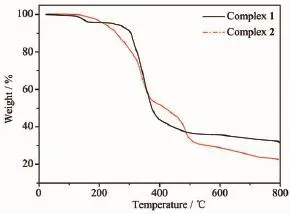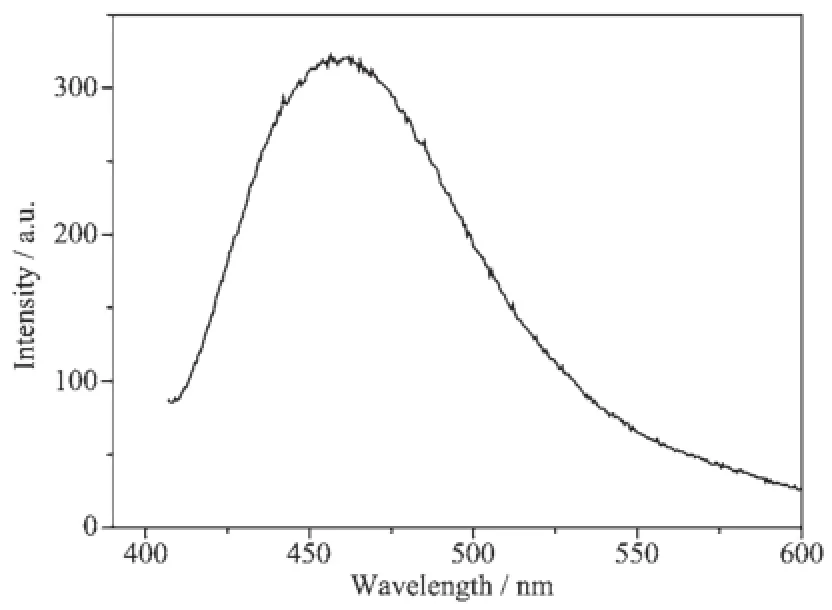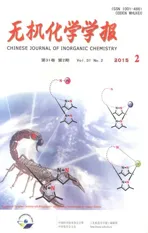含硫柔性二苯甲酸及氮杂环配体的Zn(Ⅱ)和Mn(Ⅱ)配合物的合成及晶体结构
2015-04-01郝晓敏谷长生韩丝银范润珍李泳宋文东
郝晓敏 谷长生*, 韩丝银 范润珍 李泳 宋文东
(1广东海洋大学理学院,湛江524088)
(2广东海洋大学食品科技学院,湛江524088)
(3浙江海洋学院石化与能源工程学院,舟山316000)
含硫柔性二苯甲酸及氮杂环配体的Zn(Ⅱ)和Mn(Ⅱ)配合物的合成及晶体结构
郝晓敏1谷长生*,1韩丝银2范润珍1李泳1宋文东*,3
(1广东海洋大学理学院,湛江524088)
(2广东海洋大学食品科技学院,湛江524088)
(3浙江海洋学院石化与能源工程学院,舟山316000)
以2,2′-二硫代二苯甲酸、2,2′-联吡啶、咪唑、硝酸锌和硝酸锰为原料,使用水热方法合成了配合物[Zn(EBLA)(2,2′-bipy) (H2O)](EBLA=2,2′-二苯甲酸硫醚)(2,2′-bipy=2,2′-联吡啶)(1),自然挥发法制备了配合物[Mn(EBSA)(im)2(H2O)]n(EBSA=2,2′-二硫代二苯甲酸)(im=咪唑)(2)。利用元素分析、红外和热重分析对其进行了表征。利用X-射线单晶衍射对结构进行了测定,并研究了配合物1的荧光性质。配合物1中,2,2′-二苯甲酸硫醚是通过水热方法由2,2′-二硫代二苯甲酸发生原位反应制备,Zn2+离子是五配位的四角锥双核结构;配合物2中,Mn2+离子是六配位的变形八面体一维链状结构。配合物中存在氢键和π-π堆积等弱的分子间作用力。
2,2′-二硫代二苯甲酸;2,2′-二苯甲酸硫醚;原位反应;晶体结构
0 Introduction
During the past decade,metal-organic frameworks (MOFs)attractconsiderableinterestofchemists because of the realization of interesting architectures and potential properties such as gas storage,nonlinear optics,magnetism,luminescence,catalysis[1-5]and so on.Currently,appropriate selection of multifunctional organic ligands and controlling reaction condition are keyfactorsforachievingexpectedmetal-organic frameworks(MOFs)[6-7].Aromatic-carboxylic ligands can provide various coordination modes(monodentate, bis-monodentate and so on)and widely used for building various structural and topological coordination polymers with metal ions.It is well known that the flexible 2,2′-dithiosalicylic acid(EBSA)is a preeminent candidate for constructing novel structures[8-10]. Moreover,disulfides have proven to be desirable objects for the in situ reaction because of versatile S-S transformations through the facile cleavage of S-S which can occur both reductively and oxidatively[11-14]. In this study,we introduced 2,2′-dithiosalicylic acid (EBSA)with the nitrogen heterocyclic ligands in order to assemble Zn(Ⅱ)and Mn(Ⅱ)coordination polymer. Unexpectedly,in situ reaction of 2,2′-dithiosalicylic acid provided 2,2′-dicarboxydiphenylthioether(EBLA) ligand in the presence of Zn(Ⅱ)ions.In addition, thermal stability of complexes 1 and 2 and luminescent property of complex 1 were measured and discussed.
1 Experimental
1.1 Materials and measurements
All chemicals purchased were of reagent grade andusedwithoutfurtherpurification.Elemental analysis were performed on a CARLO ERBA 1106 analyzer,it shows the percentage of carbon,hydrogen and nitrogen of the complexes.The FT-IR spectra were recorded on a BRUKER EQUINOX 55 FT-IR spectrometer using KBr pellet at a resolution of 0.5 cm-1(400~4 000 cm-1).Luminescence spectra for crystalsolidsampleswererecordedatroom temperature on a PERKIN ELMER LS 55 luminance meter.Thermogravimetry analyses were performed on an automatic simultaneous thermal analyzer(PE TG/ DTA 6300)under a flow of N2at a heating rate of 10℃·min-1between ambient temperature and 800℃.
1.2 Synthesis of[Zn(EBLA)(2,2′-bipy)(H2O)](1)
2,2′-dithiosalicylic acid(0.304 3 g,1.0 mmo1), 2,2′-bipy(0.156 2 g,1.0 mmo1)and Zn(NO3)2·6H2O (0.297 5 g,1.0 mmo1)were added in a mixed solution of DMF(N,N-dimethylformamide),water and methanol (1∶6∶1,V/V,16 mL).The vial was sealed and heated at 180℃for four days.After being cooled to room temperature,dark yellow crystals were obtained in 35%yields(based on Zn).Analysis calculated for C48H36N4O10S2Zn2(%):C 55.32,H 3.54,N 5.47;Found (%):C 55.09,H 3.49,N 5.39.IR(KBr pellet,cm-1): 3 337(s),1 629(s),1 595(s),1 579(s),1 493(s),1 474 (m),1 445(s),1 376(s),1 279(m),1 255(m),1 060(m), 1 026(m),829(m),757(s),462(m).
1.3 Synthesis of[Mn(EBSA)(im)2(H2O)]n(2)
Mn(NO3)2·4H2O(0.251 0 g,1.0 mmol),2,2′-dithiosalicylic acid(0.304 3 g,1.0 mmol)and imidazole (0.136 1 g,2.0 mmol)were dissolved in methanol and water(1∶10,V/V,30 mL)solution and the pH value was adjusted to 7 with 0.1 mol·L-1potassium hydroxide solution.After the mixture was stirred for 45 min. Colorless crystals of complex were obtained by evaporation of the solution for 8 days at room temperature in 41%yields(based on Mn).Analysis calculated for C20H18N4O5S2Mn(%):C 46.78,H 3.54,N 10.92;Found (%):C 48.09,H 3.49,N 10.67.IR(KBr pellet,cm-1): 3 691(s),3 504(w),3 445(w),3 321(s),3 139(w), 1 622(s),1 591(m),1 574(m),1 517(m),1 391(s), 1 374(w),1 282(w),1 162(w),1 133(w),1 064(m), 944(w),740(m),654(m),509(w).
1.4 Crystal structure determination
Single-crystalX-raydiffractionmeasurements were carried out on a Bruker SMART APEXⅡCCD diffractometer.The diffraction data were collected with Mo Kα radiation(λ=0.071 073 nm).Empirical absorption corrections were carried out by using the SADABS program[15].Thestructures were solved by direct methods,and all of the non-hydrogen atoms were refined anisotropically on F2by the full-matrix leastsquares technique using the SHELXL crystallographicsoftware package[16].The hydrogen atoms were added theoretically,riding on the concerned atoms and refinedwithfixedthermalfactors.Thecrystal structure data of complexes 1 and 2 were listed in Table 1.The selected bond lengths and bond angles were listed in Table 2 and hydrogen bond lengths and bond angles were listed in Table 3.
CCDC:998513,1;1000616,2.

Table 1Crystal data and structure refinements of complexes 1 and 2

Table 2Selected bond lengths(nm)and bond angles(°)for complexes 1 and 2

Continued Table 2

Table 3Hydrogen bonds for complexes 1 and 2
2 Results and discussion
2.1 Structure description of[Zn(EBLA)(2,2′-bipy)(H2O)](1)
The molecular structure of the complex 1 is shown in Fig.1 and the selected bond distances and angles are listed in Table 2.The X-ray diffraction analysis shows that this complex has a dinuclear structure.Each EBLA2-ligand has one coordination types of monodentate modes.The Zn(Ⅱ)ion is fivecoordinated by two carboxylate O atoms from two different EBLA2-groups,and two N atoms from one 2,2′-dipyridylco-ligandsaswellasonewater molecule,and the local coordination sphere around the Zn(Ⅱ)ion can be described as a distorted square pyramidal with a ZnO3N2chromophore.Atoms OW, O4i,N1 and N2 define the equatorial plane,while carboxylate O2 atoms occupies the apical site(Fig.1 (a)).Two Zn(Ⅱ)atoms are double-bridged by two EBLA2-ligands,generating a macrocyclic ring with the Zn…Zn separation distance of 0.677 3 nm(Fig.1 (b)).The dihedral angle between two benzene ring plane of EBLA2-ligand is 84.74(7)°,and the bond angle(C7-S1-C8)is 101.57(9)°.The coordinated water molecule OW form intramolecular hydrogen bond with the coordinated EBLA2-ligand O1,with the O…O bond length of 0.260 0(2)nm and the OW-H1W…O1 bond angle of 153.9°(Table 3).
There is π-π stacking interactions between nitrogen heterocyclic rings of 2,2′-dipyridyl.The centroids Cg1(coordinate:0.155 32,0.086 00,0.052 28)and Cg4(coordinate:0.344 68,0.414 00,-0.052 28)ismade up of atoms of N1,C15,C16,C17,C18 and C19, moreover,the centroids Cg2(coordinate:0.211 08, 0.360 55,0.110 05)and Cg3(coordinate:0.288 92, 0.139 45,-0.110 05)is made up of atoms of N2, C20,C21,C22,C23 and C24.The centroid-centroid distance(Cg1-Cg2 and Cg3-Cg4)and the dihedral angle between two pyridyl ring plane(Cg1-Cg2 and Cg3-Cg4)is 0.378 71 nm and 10.028°,respectively.In complex 1,π-π stacking interactions and intermolecular hydrogen bonding(C5-H5…O3iii,d(H…O)= 0.255 37(18)nm)formed the two-dimensional layer structure.With the help of hydrogen-bonded interactions between adjacent 2D sheet(OW-H2W…O4ii, d(H…O)=0.197 77(13)nm),the polymeric sheet are assembled to form a supramolecular 3D network structure(Fig.2).

Fig.1(a)Coordination environment of Zn(Ⅱ)in 1 with the ellipsoids drawn at the 30%probability level; (b)Dual-molecular structure of complex 1

Fig.22D and 3D structure of complex 1
2.2 Structure description of[Mn(EBSA)(im)2(H2O)]n(2)
As shown in Fig.3,each Mn(Ⅱ)atom is in a distorted octahedral coordination environment,defined by three carboxyl O atoms from two different EBSA2-groups and two N atoms from the two imidazole ligands in complex 2.Its equatorial plane is defined by the atoms of O1,O2,O4iand N3(Rms deviation offitted atoms=0.007 52 nm;deviation of Mn atom from this plane is 0.001 49 nm).The axial positions are occupied by the atoms of O1W and N1,with an angle of 174.83(8)°.The imidazole molecules act as typical monodentate ligands terminally coordinated to the metal center.The Mn-O(carboxyl)distances(Table 2) are in the range of the corresponding bond distances of Mn-terephthalate complexes(0.211 3(2)~0.232 39(18) nm).It should be noted that the O4-C14 distance (0.125 9(3)nm)is longer than the O3-C14 distance (0.123 8(3)nm),agreeing with the greater doublebond character of the latter bond.In contrast,the O1-C1(0.127 0(3)nm)and O2-C1(0.125 4(3)nm)distances are nearly identical,suggesting delocalization of electrons throughout.This can be explained by the influence of the different coordination modes of the carboxyl groups.In the former(O3-C14-O4),the carboxyl group is in a monodentate mode through the O4 atom,and the other carboxyl group(O1-C1-O2)is in a bidentate chelating mode through atoms O1 and O2.Thedihedralanglesbetweentwoimidazole and between two benzene ring plane of EBSA are 87.01(15)°and 84.25(12)°,respectively.The torsion angles of-82.87(12)°[C7-S1-S2-C8]distinction may beattributedtotheremarkableconformational flexibility of EBSA2-ligand.

Fig.3Coordination environment of Mn(Ⅱ)in 2 with the ellipsoids drawn at the 30%probability level
Each EBSA group adopts a tridentate coordinated mode to link two Mn(Ⅱ)atoms into a one-dimensional infinite linear chain.In the chain,the adjacent Mn…Mn distance is 1.257 2(5)nm.The N4 and C4 atoms and the O1 and S1 of EBSA ligand form intramolecular hydrogen bonds(N4-H4N…O1vand C4-H4…S1vi),with bond distances of 0.236 84(19)(H…O)and 0.277 24(12)(H…S)nm,and the bond angles of 136.4°and 165.6°,respectively,leading into a twodimensional layer structure.Furthermore,such layer are connected through intermolecular hydrogen bonds (O1W-H2W…O2iii)involving the coordination water molecules and oxygen atoms of EBSA2-groups, yieldingathree-dimensionalhydrogen-bonding supramolecular network(Fig.4).

Fig.42D and 3D structure of complex 2
2.3 IR Spectrum and thermal analysis
In the complex 1,the characteristic band at 3 337 cm-1reveals existence of H2O molecule.While the absorption band at 3 321,3 139 cm-1in complex 2 were attributed to the O-H and-N-H characteristic stretchingvibrationsofH2Oandimidazole, respectively,corresponding to the known structure. The IR spectra of the complex 1 exhibit the typical antisymmetric 1 629,1 595 cm-1and symmetric 1 376 cm-1stretching bands of two carboxy groups,and the values Δν(νas(COO-)-νs(COO-))of 253 and 219 cm-1, respectively,indicate that EBLA2-(2,2′-dicarboxydiphenylthioether)is monodentate.In the compound 2, the absorptions at 1 622,1 517 cm-1and 1 391,1 374 cm-1correspond to asymmetric νas(COO-)and symmetrical νs(COO-)stretching vibrations of the coordinatedcarboxylate groups.The Δν(νas(COO-)-νs(COO-))value is 231 and 143 cm-1,respectively.We can infer that the two carboxylate groups show monodentate and bidentate-chelatingcoordinationmode.Meanwhile, characteristic bands 1 579,1 445 cm-1in 1 and 1574 cm-1in 2 belong to the stretching vibration of-N=C-of 2,2′-dipyridyl[17]and imidazole[18]ligands,respectively.The characteristic bands 1 376,829 cm-1in 1 belong to the stretching vibration of-S-ν(aromatic)of EBLA ligand[19].In addition the weak absorptions at 1 162,1 133 and 509 cm-1in 2 belong to the stretching vibration of-S-S-ν(aromatic)of EBSA ligand[20].The results of the IR spectra analyses of the complexes are inconsistentwiththatofsingle-crystalX-rayanalyses.
The thermal stability and thermal decomposition behavior of complexes 1 and 2 were studied by thermal analysis in a static N2atmosphere in the temperature range of 30~800℃,as shown in Fig.5.In complex 1,the first weight loss corresponding to the escape of one coordinated water molecule is observed from 30 to 166℃(Obsd.3.90%,Calcd.3.52%).The second weight loss corresponding to the escape of EBLA2+ligand is observed from 279 to 516℃(Obsd. 53.15%,Calcd.56.72%).In complex 2,the weight-loss step occurs from 99 to 487℃(Obsd.62.71%,Calcd. 62.87%),which corresponds to the decomposition of framework structure by losing one coordinated water molecule and EBSA2+ligand.Complexes 1 and 2 slowly start to decompose after 517 and 488℃,respectively, which is similar with[Co(bpp)(H2O)(nip)]n[21].

Fig.5Thermogravimetric curves(TG)for 1 and 2
2.4 Photoluminescence properties
Coordination polymers based on d10metal centers and organic ligands are promising candidates for photoactive materials with potential applications.For complex 1,fluorescent property of compound has been investigated in the solid state.2,2′-bpy shows strong emission peak centered at 530 nm upon excitation at 342 nm and the emission peaks were not observed for free EBLA(2,2′-dicarboxydiphenylthioether)ligand because the EBLA ligand was obtained by hydrothermal in situ ligand syntheses.When these ligands complexed with Zn(Ⅱ)atoms,strong fluorescence with emission broad peak centered at 460 nm(λex=387 nm) for complex 1 was observed at room temperature(Fig. 6),which may originate from the π-π*transition emission of ligand-to-ligand charge transfer(LLCT)in aromatic rings of the two ligands[22].

Fig.6Solid-state photoluminescent spectrum for 1
3 Conclusions
In conclusion,two new Zn(Ⅱ)and Mn(Ⅱ)complexes, [Zn(EBLA)(2,2′-bipy)(H2O)]and[Mn(EBSA)(im)2(H2O)]n, has synthesized and structurally characterized.The complex 1,2 is a dinuclear and a one-dimensional infinite linear chain structure,respectively.The 2,2′-dithiosalicylic acid in situ reaction provided 2,2′-dicarboxydiphenylthioether(EBLA)ligand at 180℃by hydrothermal method.Complex1 emitsintensely luminescence with the fluorescence of 460 nm in solid state at room temperature.
Acknowledgements:The authors thank the foundation of GuangdongprovinceandZhanjiangcity(grantNo. S2012020011054,2011B090400415 and 2011C3108001)and chemical experiment center of Guangdong Ocean University for supporting this work.
References:
[1]Jiang J,Yu J,Corma A.Angew.Chem.Int.Ed.,2010,49: 3120-3145
[2]Lee L W,Vittal J J.Chem.Rev.,2011,111:688-764
[3]Deng Z P,Huo L H,Li M S,et al.Cryst.Growth Des.,2011, 11:3090-3100
[4]Zhang Z Y,Deng Z P,Huo L H,et al.Inorg.Chem.,2013, 52:5914-5923
[5]MA Zhi-Feng(马志峰),ZHANG Ying-Hui(章应辉),HU Tong -Liang(胡同亮),et al.Chinese J.Inorg.Chem.(无机化学学报),2014,30(1):204-212
[6]Li J R,Ma Y G,Mcarthy M C,et al.Coord.Chem.Rev., 2011,255:1791-1823
[7]ZHAO Yue(赵越),ZHAI Ling-Ling(翟玲玲),SUN Wei-Yin (孙为银).Chinese J.Inorg.Chem.(无机化学学报),2014,30 (1):99-105
[8]Feng R,Jiang F L,Chen L,et al.Chem.Commun.,2009: 5296-5298
[9]Murugavel R,Baheti K,Anantharaman G.Inorg.Chem., 2001,40:6870-6878
[10]Yu J H,Yao R,Yuan L M,et al.Inorg.Chim.Acta,2011, 376:222-229
[11]Bu Y,Jiang F L,Zhang S Q,et al.CrystEngComm,2011, 13:6323-6326
[12]Wang J,Zheng S L,Hu S,et al.Inorg.Chem.,2007,46:795-800
[13]Han L,Bu X H,Zhang Q C,et al.Inorg.Chem.,2006,45: 5736-5738
[14]Humphrey S M,Mole R A,Rawson J M,et al.Dalton Trans., 2004:1670-1678
[15]Sheldrick G M.SADABS,Siemens Area Detector Absorption Corrected Software,University of Göttingen,Germany,1996. [16]Sheldrick G M.SHELXL-97,Program for the Refinement of Crystal Structure,University of Göttingen,Germany,1997.
[17]ZHAO Yong-Liang(赵永亮),ZHAO Feng-Ying(赵凤英). Spectrosc.Spect.Anal.(光谱学与光谱分析),2000,20(6): 822-824
[18]YANG Hui(杨卉),DING Yi-Gang(丁一刚),YANG Chang-Yan(杨昌炎),et al.J.Wuhan Inst.Tech.(武汉工程大学学报),2011,11:19-22
[19]Bhubon S R K,Abdul M K M,Ozra G M S,et al.Inorg. Chem.Commun.,2001,4:315-318
[20]Grant A B,Ryan P A B,Edward R T.CrystEngComm, 2008,10:879-887
[21]XIANG Lei(向磊),GUO Xiao-Fang(郭小芳),LI Xin-Xiong (李新雄),et al.Chinese J.Struct.Chem.(结构化学),2013, 32(11):1680-1686
[22]ZHAO Xiu-Hua(赵秀华),ZHAO Ya-Yun(赵亚云),ZHANG Jie(张洁),et al.Chinese J.Inorg.Chem.(无机化学学报), 2014,30(3):633-639
HAO Xiao-Min1GU Chang-Sheng*,1HAN Si-Yin2FAN Run-Zhen1LI Yong1SONG Wen-Dong*,3
(1Department of Applied Chemistry,Guangdong Ocean University,Zhanjiang,Guangdong 524088,China)
(2College of Food Science and Technology,Guangdong Ocean University,Zhanjiang,Guangdong 524088,China)
(3School of Petrochemical&Energy Engineering,Zhejiang Ocean University,Zhoushan,Zhejiang 316000,China)
Two coordination polymers[Zn(EBLA)(2,2′-bipy)(H2O)](1)and[Mn(EBSA)(im)2(H2O)]n(2)were synthesized by hydrothermal and evaporation methods using 2,2′-dithiosalicylic acid(EBSA),2,2′-dipyridyl, imidazole,Zn(NO3)2·6H2O and Mn(NO3)2·4H2O.And the complexes were characterized by elemental analysis,FTIR and thermogravimetrie analysis(TGA),meanwhile the crystal structures and fluorescence properties of the complex 1 have been studied.In complex 1,2,2′-dicarboxydiphenylthioether(EBLA)was prepared with 2,2′-dithiosalicylic acid(EBSA)in situ reaction by hydrothermal method.The complex 1 is a dinuclear structure and Zn2+ion is five-coordination in a distorted square pyramidal geometry;The complex 2 is a one-dimensional infinite linear chain and Mn2+ionis six-coordination in a distorted octahedral geometry.Hydrogen bonding and ππ interactions are observed in these complexes.CCDC:998513,1;1000616,2.
2,2′-dithiosalicylic acid;2,2′-dicarboxydiphenylthioether;in situ reaction;crystal structure
O614.24+1;O614.7+11
A
1001-4861(2015)02-0369-08
10.11862/CJIC.2015.052
2014-09-02。收修改稿日期:2014-11-02。
广东省自然科学基金(No.S2012020011054)、2011年省部产学研结合引导项目(No.102011B090400415)和2011年度湛江市第八批科技攻关计划项目(No.2011C3108001)资助。
*通讯联系人。E-mail:gcsheng1968@126.com,swd60@163.com;会员登记号:S060016145M。
Syntheses,Crystal Structures of Zn(Ⅱ)and Mn(Ⅱ)Complexes with Flexible Sulfur Containing Aromatic Acid and Nitrogen Heterocyclic Ligands
